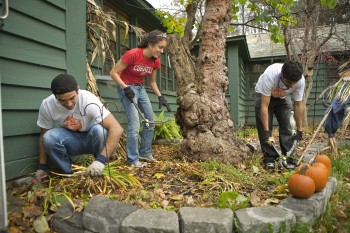CAMPUS LIFE

The Cayuga Nature Center gets a fall cleaning by, from left, Josh Rosario 10, Neesha Schnepf 13 and Vanish Grover 10 during the Into the Streets day of service Oct. 31. See larger image
Service learning takes students into the streets and back to the classroom
In January, students and alumni spread out to lend a hand in more than two dozen cities for Cornell Cares Day. In August, about-to-be freshmen go out into the community for Pre-Orientation Service Trips. (See slideshow on the Multimedia Page.) And on Oct. 31, students fan out for a day of service in the Ithaca area. These events constitute the most visible face of Cornell's Public Service Center (PSC), which every year sends hundreds of students into the community to make a difference.
But since its launch in 1991, the PSC has grown into an organization far larger and more complex than one just for recruiting volunteers. It now provides mini-grants to faculty, enhances core university curricula and promotes the importance of scholarship in the field -- service learning -- by partnering with faculty to take the experience of the streets into the classroom.
Six thousand Cornell students a year participate in these service-learning courses, as well as projects and events, such as alternative spring breaks, tutoring pre-K through high school students, and going into local schools to enhance science curricula. Students can also apply to PSC for funding and faculty mentorship to help them develop leadership skills as they tackle community service-learning projects and social advocacy work.
More than 150 faculty members also are involved with at least 60 service-learning courses and collaborations with PSC, and they can apply for mini-grant funding. The PSC connects with Cornell alumni through events like Cornell Cares Day and with community leaders through the Civic Leaders Fellowship program and many local volunteer projects.
Two service-learning courses have found a natural home in Cornell's West Campus House System. Jefferson Cowie, ILR School associate professor, teaches a Keeton House service-learning course called Sustainable Ithaca, which, he says, encapsulates what the West Campus living-learning experience is all about -- a community of students engaged in academic service-learning, embedded in the larger community.
Students in the course have fanned out across the campus and the county, doing projects ranging from identifying local sources for campus food to making houses more energy efficient. "Our goal is to get far beyond simple volunteering to link students' academic skills with community needs, and then wrap both up in an interdisciplinary understanding of global sustainability," Cowie says.
Service-learning courses have sprung up across disciplines and colleges. History and Latino studies professor Maria Cristina Garcia, who teaches a history department course on immigration, says she incorporated service-learning into her teaching to persuade Cornell students to learn more about immigrants who live in Ithaca and Tompkins County. "Undergrads spend four years in Ithaca, but many never have a sense of the people who live here," she says. "It's a shame because Ithaca and Tompkins County have an incredibly diverse population which includes first-generation immigrants and refugees from all over the world." It's also important, she says, for students to see how theory plays out in the real world.
Faculty members are looking for ways to address challenges that come up while teaching service-learning courses and to assess the impact on the community, says Leonardo Vargas-Méndez, the PSC's executive director. Two powerful influences are a seminar series that brings experts on service-learning curricula to Cornell and an annual global service-learning institute each March.
"It's a scholarship approach that is grounded in the academic part of the house and has the potential to become a transformative experience not only for communities, faculty and students, but for the entire institution," he says.